Trees Birds Mammals Fish Amphibians Reptiles
Wild Algarve
Bookshop
Hydnellum concrescens (Pers.) Banker - Zoned Tooth
Phylum: Basidiomycota - Class: Agaricomycetes - Order: Thelephorales - Family: Bankeraceae
Distribution - Taxonomic History - Etymology - Identification - Culinary Notes - Reference Sources
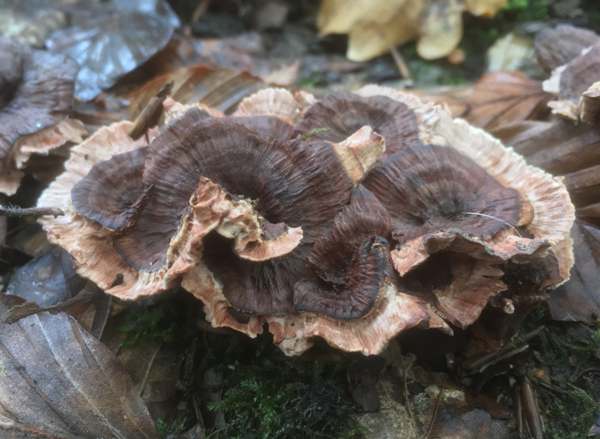
Above: Hydnellum concrescens, New Forest, southern England
The Zoned Tooth is an uncommon to rare woodland mushroom and, as with other Hydnellum species in Britain, it is a Biodiversity Action Plan (BAP) species. It seems likely that in Britain there are at least two species hidden under this scientific nanme. In Scotland, the Zoned Tooth often occurs under conifers such as pines (Pinus spp.) or spruces (Picea spp.), whereas in southern England this hydnoid mushroom is found mostly in broadleaf woodland under Beeches (Fagus spp.) and Oaks (Quercus spp.) but also occasionally in mixed broadleaf/conifer woodland.
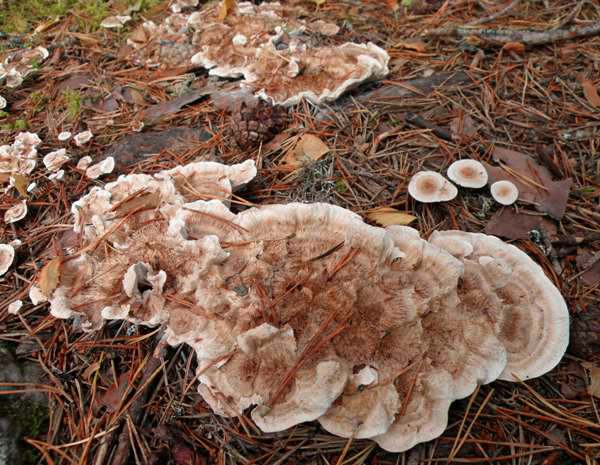
Above: Hydnellum concrescens, Caledonian Forest, Scotland
When in conifer woodland, Zoned Tooth fungus blends in with (and often engulfs) needles on the forest floor and so can easy be overlooked. Although very variable in cap shape and colour, the gregarious fruitbodies tend to fuse together and can form quite large masses with several stems.
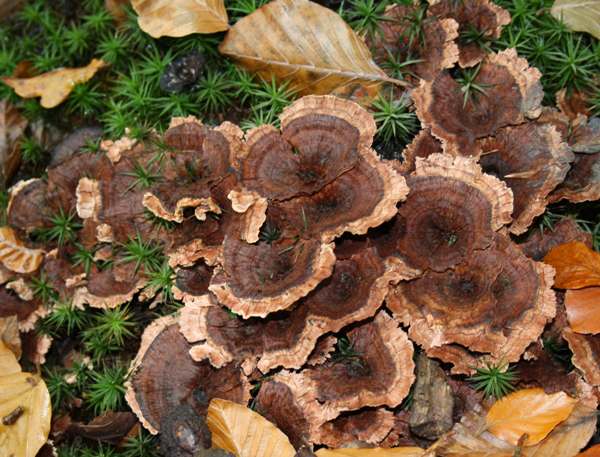
Distribution
In Britain Hydnellum concrescens is reported mainly from southern England and from Scotland. This species is recorded from many European countries and from parts of North America and Japan.
Taxonomic history
Tooth fungi of various kinds can be found in many taxonomic orders, and over the years their classification has changed considerably. The basionym of Zoned Tooth was set in 1796 when this species was described scientifically by Christiaan Hendrik Persoon, who gave it the binomial name Hydnum concrescens. The currently-accepted scientific name of this fungus dates from 1906, when American mycologist Howard James Banker (1866 - 1940) transferred this species to the genus Hydnellum.
Synonyms of Hydnellum concrescens include Hydnum concentricum (Fr.) P. Karst., Hydnum zonatum Batsch, Hydnum concrescens Pers., Hydnum queletii Fr., Hydnellum zonatum (Batsch) P. Karst., and Hydnellum velutinum var. zonatum (Batsch) Maas Geest.
Etymology
Hydnellum, the generic name, is derived from the ancient Greek word hudnon, meaning an edible mushroom; this term was applied particularly to edible truffles. (See, for example, Tuber melanosporum, the Perigord Truffle.)
The specific epithet concrescens means congealed - a reference to the habit of Zoned Tooth fruitbodies of merging and fusing together to form large compound ground-hugging fruitbodies.
In Britain this 'hydnoid' (toothed) fungus is a Biodiversity Action Plan (BAP) species.
Identification Guide
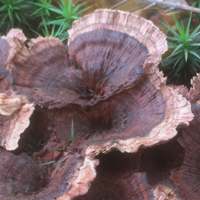 |
Cap
Individual caps range from 2 to 5cm across when fully developed, sometimes round but often oval or multi-lobed; initially shallowly domed or flat topped but with a finely velvety bumpy surface, becoming slightly funnel-shaped; concentically zoned, white or very pale pinkish-buffnear the margin, becoming reddish brown from the centre before blackening and decaying. The cap flesh is tough and fibrous. Above-ground height 3 to 6cm. |
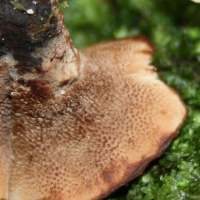 |
Spines
1 to 5mm long (shortest near to the cap margin) and less than 1mm in diameter; crowded, decurrent; pinkish buff, becoming darker as the spores mature.
Stem
Sometimes as squat as just 1cm in height; occasionally as tall as 3 or 4cm but with much of the stem below ground; diameter 0.7 to 2cm, tapering towards base. |
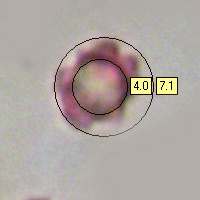 |
Spores
Irregularly subspherical, 4.5-6 x 3.5-4.5µm excluding warts; ornamented with coarse warts; inamyloid.
Spore print
Dull brown. |
Odour/taste |
Odour slightly farinaceous; taste bitter. |
Habitat & Ecological role |
Mycorrhizal, on soil in woodlands. In southern Britain nearly always with Oaks present but also associated with Beech, Birches, Sweet Chestnut and occasionally conifers. In Scotland often under conifers including Spruces, Pines and Yew. |
Season |
Late summer and autumn in Britain. |
Similar species |
Hydnellum scrobiculatum is very similar but is found under pine trees; it has slightly smaller spores.
Hydnum rufescens is
tan coloured without concentric zones; its spines are adnate to the stem rather
than decurrent. |
Culinary Notes
Zoned Tooth is a tough and insubstantial fungus. The fact that the fruitbodies are long-lasting suggests that other creatures also find the Zoned Tooth hard to chew and swallow (although it is possible that these fungi contain chemicals that grazing animals do not like). Needless to say we have no recipe information for this species.
Reference Sources
Fascinated by Fungi, 2nd Edition, Pat O'Reilly 2016, reprinted by Coch-y-bonddu Books in 2022.
David Parfitt, Martyn Ainsworth, Deborah Simpson, Hilary J. Rogers & Lynne Boddy, Molecular and morphological discrimination of stipitate hydnoids in the genera Hydnellum and Phellodon; Mycological Research, Volume 111, Issue 7, July 2007, Pages 761-777.
Dictionary of the Fungi; Paul M. Kirk, Paul F. Cannon, David W. Minter and J. A. Stalpers; CABI, 2008
Taxonomic history and synonym information on these pages is drawn from many sources but in particular from the British Mycological Society's GB Checklist of Fungi.
Acknowledgements
This page includes pictures kindly contributed by Simon Harding.
Top of page...
Fascinated by Fungi. Back by popular demand, Pat O'Reilly's best-selling 450-page hardback book is available now. The latest second edition was republished with a sparkling new cover design in September 2022 by Coch-y-Bonddu Books. Full details and copies are available from the publisher's online bookshop...